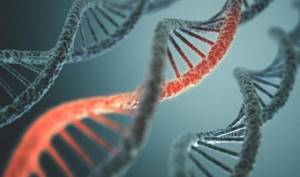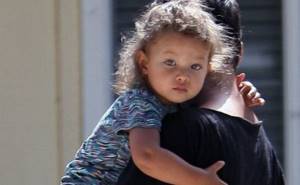Before the baby is born, we all wonder what he will be like? Light or dark? Brown-eyed or blue-eyed? Curly or straight hair?
However, the science of genetics can determine all this long before the birth of a child. And today we will talk about some of the main parameters that determine the appearance of a child and which parent he will be more like.
Eye color
Typically, the blue-eyed gene is weak (recessive), and the brown-eyed gene is strong (dominant). If a child receives the blue-eyed gene from one parent and the brown-eyed gene from the other, his eyes will most likely be brown.
Parents with black-black eyes cannot expect blue-eyed children. Those with brown, hazel or honey eyes may well have blue-eyed children, but more often they end up with brown eyes. Gray-eyed and blue-eyed couples are more likely to have the same children.
Straight hair or curls?
Blonde hair is also a recessive gene. If mom and dad are fair-haired, the baby will turn out to be fair-haired. And if one of the parents has dark hair and the other has light hair, the child’s hair will be dark or a medium shade between the hair color of dad and mom. Just keep in mind that the descendants of the Eastern Slavs are all fair in early childhood, and only by the age of 10-12 do their hair acquire the shade that remains for the rest of their lives.
Curliness is the dominant feature. If at least one parent has curly hair, the child is likely to also have curls or at least wavy hair.
Humped nose and protruding ears
With a high probability, the baby may get a dimple on the chin if one of the parents has one, as well as large ears. Some geneticists believe that genes responsible for the shape of a large, hump nose are also dominant.
High or low?
But it is difficult to predict the growth of an unborn child. Usually, with tall parents, the child most likely will not be small either, but as a rule, the child stops at the average between the heights of mom and dad. However, if the baby eats well as a child, moves a lot and sleeps the prescribed hours, he has a chance to outgrow his short parents.
Is it true that girls more often look like dads, and boys more like moms?
Indeed, boys are more likely to look like their mothers. They inherit only one X chromosome from their mother, and this chromosome is rich in genes responsible for appearance: the shape of the eyebrows, the shape of the face, skin color...
For girls the situation is different. They receive one X chromosome from their mother and one from their father, so they are equally likely to resemble both parents.
It's just random randomness
When you conceive, you receive one set of chromosomes from your mother and another set from your father. Which one exactly is a mystery, just an accident that no one can influence yet. But there is such a thing as dominant genes, that is, strong genes that “clog” all the others. For example, it happens that in a family all the children look like their dad. He has strong genes. Scientists have determined which traits are passed on to children first, but more on that below.
It does not happen that one child is an exact copy of one of the parents. And the other - another. Children are not our clones. In any case, they receive part of their genes from their father, part from their mother, but you also received part of your genes from your parents, so your children will already have a whole gene “cocktail”. Is it possible to predict what your child will become? Only partly, and even then not exactly. While appearance can still be somehow predicted, character traits are unlikely. Their formation is greatly influenced by the environment, living conditions and much more.
Both in character and in her father’s face: what the eldest daughter of Great Marshal Zhukov looked like
How to make delicate earrings with pearls with your own hands: an easy way
I saw a friend screwing 3 toothpicks into a head of lettuce: she started doing the same
Who inherits what?
Certain qualities are often mistakenly attributed to the father, although he is not responsible for it. Scientists have found that it is not the father, but the maternal grandfather who is responsible for hair loss. In general, children inherit significantly more from their mothers than from their fathers.

This is due to differences in the 23rd pair of chromosomes: a woman has a double XX chromosome with 1100 genes, and a man's Y chromosome contains 80 genes. Thus, some diseases can only be inherited from the mother. But some characteristics are also transmitted from the father: for example, a son inherits his father's tendency to have sons or daughters. If a man has many sisters, then he himself will also have more daughters. If he has brothers, he will most likely have sons.
Royal Enfield has released a women's collection of motorcycle equipment for the first time
Prepares quickly and eats the same way: a recipe for delicious crispy nacho pizza
Workouts, picnics, and more in our dating guide
Gene difference and external features

If we talk about appearance, then boys really look like their mothers more often. And that's why. They inherit one X chromosome - their mother's. It contains maximum information about external features. The second, the Y chromosome from dad, is almost not responsible for appearance. The son has a better chance of being like his mother. But the girl gets two X chromosomes - from her mother and from her father. Therefore, a girl can be equally similar to both her mother and her father.
There is also such a thing as family traits. These are appearance features that are passed down from generation to generation to both daughters and sons. For example, the sixth finger, cleft lip or malocclusion. Genetics do not yet know how to influence this phenomenon, whether it can be controlled.
Scientists have determined who children are more like
Foreign researchers have come to certain conclusions.

Researchers at the University of North Carolina (USA) claim that genetically any mammal, including humans, is more like its father than its mother, RIA Novosti writes.
They note that a child receives the same amount of genetic material from mom and dad. However, the father's genes have a stronger influence on the development of the organism.
Scientists have long studied the genomes of mice bred by crossing wild and laboratory populations. After this, they measured the level of gene expression in various tissues, and then compared them with copies of parental DNA. The experiment showed that sections of the genome that were obtained through the male line had increased activity in 80% of cases, determining what the offspring would be like.
The authors of the work note that this may be true for all mammals, including humans.
At the same time, researchers from Germany believe that the life expectancy of his children largely depends on the father’s DNA. Moreover, children conceived by young fathers have a chance to live longer lives. However, American scientists do not agree with this opinion. They argue that the father's advanced age at the time of conception, on the contrary, guarantees his offspring a long life.
It is from fathers that a predisposition to cardiovascular diseases can be inherited, although only by sons. In addition, a father is capable of transmitting a tendency towards schizophrenia to his children of both sexes. Moreover, the older the parent, the higher the likelihood of getting sick. An analysis of data from more than 87 thousand people showed: among those whose fathers were over 50 years old at the time of birth, three times more patients with schizophrenia. Also, the child’s height largely depends on the father’s genes: tall men give birth to taller children of both sexes. The age of the father also influences - the older, the higher.
As for mothers, they can pass on to their baby a tendency towards being overweight or thin. At the same time, a predisposition to excess body weight is transmitted more often.
One of the most active regions of the female genome is the eighth chromosome. The authors of a scientific paper from Iceland suggest that the increased level of substitutions in this section of DNA has evolutionary significance and brings modern humans closer to the African line of apes.
Photo: pixabay.com
Author
Elvira Ayupova
Journalist
All articles by the author
I like!
leave a comment
You are here: Home » News » Scientists have determined who children are more like
Whose eyes?

This is where the law of dominant and recessive genes comes into force. Brown and black eyes are dominant. They are more often inherited than blue or green ones. But not always. After all, even a brown-eyed dad has a set of two genes. What if he has a second blue-eyed gene? Although it is weak, it is there, so theoretically it can “shoot” at any moment.
My daughter asks for more: in the summer I spoil my child with homemade Rusalochka ice cream.
Time to do yoga: teacher promises back pain will be a thing of the past
Parquet floors, a library, a basketball court - what remains of Dagdizel
But parents with light eyes can have a brown-eyed child only in exceptional cases. Just like with black-eyed people, a blue-eyed baby can appear with a probability of 1:1000000. Black eyes are generally the strongest gene; it is very difficult to “interrupt” it.
Whose hair?

Blondes carry weak genes; blond hair is probably passed on to children only from both blond parents. If dad is dark and mom is blonde, the children are more likely to have dark hair. The same goes for curliness. A dominant, strong gene is responsible for curly hair, and a weaker one for straight hair, but all this is relative. After all, each parent has their own double set of genes, so what the child will get when this whole cocktail is combined is unknown.
How tall will the child be?

In relation to growth, external factors play a very important role: how the child ate, what illnesses he had, what kind of lifestyle he led. Genetics says that children with tall parents cannot be short. Because the “tall” gene is dominant. But if a child suffered a serious illness in childhood, was poorly fed, and was not physically developed, then he can grow lower than what was programmed by his genes by birth.
There are certain traits that are more likely to be inherited. For example, a dimple on the chin, protruding ears or a hooked nose. But it is impossible to predict for sure what the child will look like. If even identical twins are sometimes born completely different, then what about ordinary children?
Genetics is so complex that even today, armed with the latest technology and knowledge, scientists have not solved even a third of its mysteries. Don't think about who your child is more like. Love him. Only you can build a happy family and a trusting relationship with your children. Genetics definitely has nothing to do with it.
Found a violation? Report content
LiveInternetLiveInternet
People fall in love, get married and start families. It doesn’t matter that two people are completely different and have very little in common, they are united by love. A special contrast is obtained in couples who are not at all similar in appearance, in those who belong to different races. And, accordingly, they give birth to children who are very different from others.
It is believed that children from mixed marriages are much healthier and more beautiful. In most cases this is true, but, unfortunately, this is observed only in the first generation and does not manifest itself in the future. It happens that people with too different genetic lines, on the contrary, may have children born weak and with various abnormalities. The reason for this is the intrauterine conflict between the fetus and the mother due to the presence of the father’s genes in the baby’s genotype.
Many people believe that all children from mixed marriages are mestizos. But it is not so. Mestizos are people born from the Mongoloid and Caucasian races. But the fruit of the combination of the Negroid and Caucasian races are mulattoes . Sambo is the name given to those people who are born from parents belonging to the Negroid and Mongoloid races. Although more often all people born from mixed marriages are called mestizos.

Now let's see who a child from a mixed marriage might look like. Thus, crossing the black and white races will always lead to the birth of a child with dark skin. And in general, he will be more like his black parent. And all because the genes that determine the main characteristics of the Negroid race are dominant in relation to the Caucasian race. These include the color of skin, eyes, hair, skull structure, shape of lips, eyes, nose and others. It is also worth noting that more or less dark skin color and obvious signs of race will depend on which parent is a representative of the Negroid race. So, for example, if the mother is white and the father is black, then the child as a result will not have such obvious signs of the Negroid race than if it were the other way around (father is white, mother is black). This happens because in the black race the X chromosome is not only the carrier of basic qualities, but also dominant over the Y chromosome. And in the white race, the Y chromosome is dominant. It follows that racial qualities in the Negroid race are most likely transmitted through the mother, and in the white race through the father. Let's not forget that this concerns the first generation of children. What will happen next is more difficult to predict.
In general, from black and white-skinned parents, a mulatto baby will be born with dark skin (various shades from black to light), dark hair and eyes, full lips, a large nose, and he himself will most likely be large . Although there are dark-skinned people with blue eyes, this is rare. In general, a wonderful and beautiful child, very different from others. Unless, of course, he was born somewhere in Latin America or where there are a lot of mulattoes. Unfortunately, in our country such children do not feel very comfortable, because they are not like everyone else and there are not so many of them.
The situation is approximately similar if the parents are representatives of the Caucasian and Mongoloid races . Mongoloid genes are dominant. Most likely, from a Russian and Chinese father, the child will be born with yellowish skin, dark hair, and slanting dark eyes. This is, let's say, a typical representative of such a mixture. Although there are cases where a child does not at all resemble his Mongoloid parent, the characteristic features of this race are likely to appear in future generations. In addition, it is worth considering that both parents are most often not pure representatives of their races. A Russian or European may have both Chinese and Japanese in his family, in general, Mongoloid blood.

And a very interesting mixture results when one of the parents is Negroid and the other is Mongoloid . Both have strong genes. But the darker skin color always dominates the lighter one. Therefore, in any case, the child will be dark, but may have a barely noticeable yellow tint, but such children may differ in other external characteristics. So, for example, the eye shape will most likely be that of the Mongoloid parent. But the body structure and tall height will be inherited from a dark-skinned parent. In addition, the hair may not be straight, like the Mongoloids, but curly, like the Negroids.
In general, genetics is a complex thing and it is problematic to reliably predict which traits he will inherit from which parent. But in any case, if this child is desired, then parents do not attach much importance to who their baby is like. After all, it didn’t bother them that they were completely different in appearance. And how others will look at it, let those around them worry.










